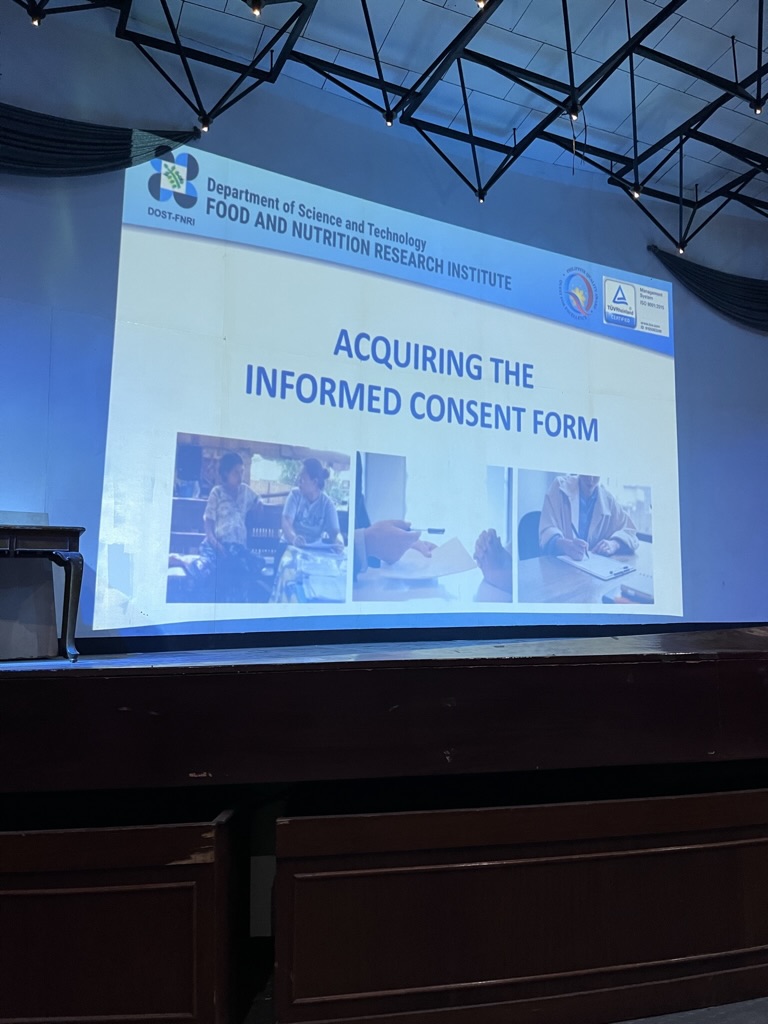

Preparing for Fieldwork
6.15 & 6.16
We went to the final send off meeting prior to our departure in the field. Each team took pictures and we are going to be traveling with both team 2 and 4. We talked about how to prepare for our departure on Monday and met with our on site supervisors to make sure everything was in place for us to leave. Our fieldwork departure date got pushed back a few days so we had a few hours to do some independent research on the FNRI enutrition website to browse all the nutrition surveys published dating back to 1978.
I experienced my first earthquake. Although I didn’t feel anything, the entire building evacuated for the 6.2 magnitude earthquake.
Second Weekend
Saturday 6.17
Tagaytay
Today we meet with a my dads friend, Jo (or batman). She picked us up at 6am to take us to Tagaytay. We spent the morning driving around to look at Taal Lake. The beautiful view made up for the many hours of motion sickness I endured. I tried bulalol right after throwing up and it cured me! We also went to a fruit market and I tried jackfruit. Jo took us to S&R (which is like CostCo) to get some snacks before our trip.
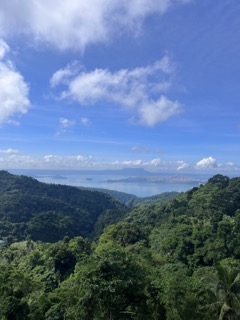
Sunday 6.18
Preparing to Leave
We spent the day catching up on sleep and preparing to leave for 8 days. First Kennady helped us unclog the toilet, which was clogged for about 4 days… you dont even want to know how badly it smelled. We also had to wash our clothes so we walked to find a laundromat. We spent a few hours washing our clothes and that took up the rest of our night. We toook our first trike back to our condo! When I got back to the condo, I packed my bags for Marinduque. We packed our clothes, toiletries, snacks, lots of toilet paper, a pillow and blanket.
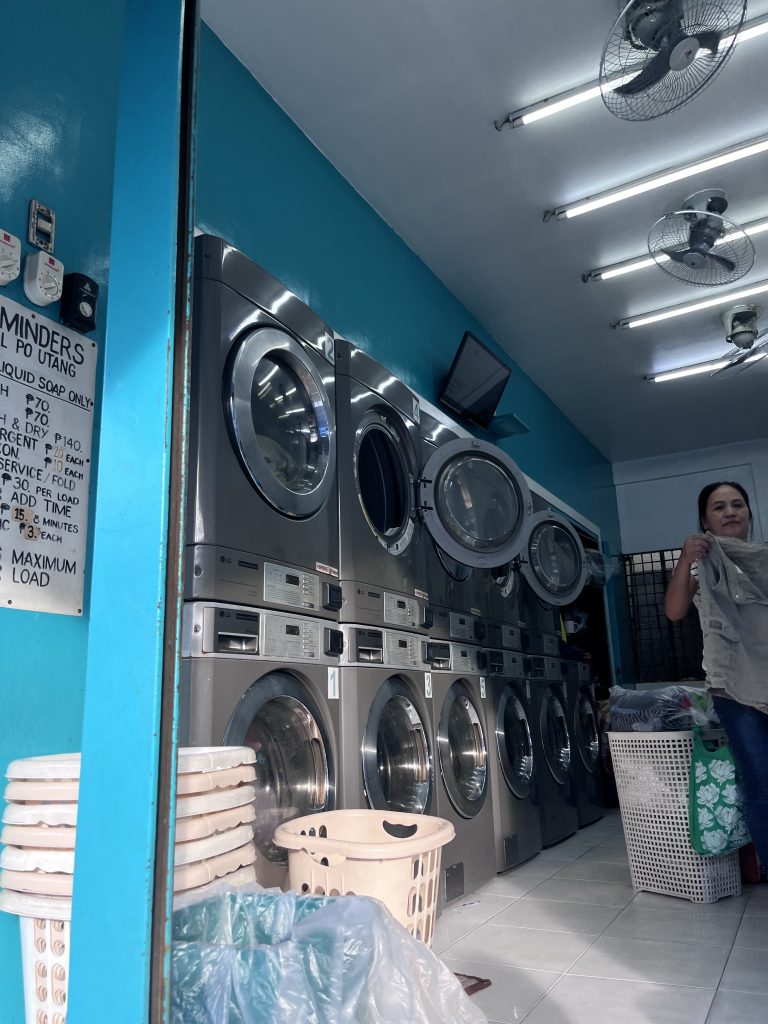
6.19 Travel to Marinduque With Team 2
There are 5 teams from NAMD currently traveling around the Philippines to conduct research for around 6 months. Each team is split up into subteams, team 2 has 7 subteams; each subteam has about seven field workers: one team leader, two anthropometric researchers, two dietary researchers, one biochemical/medical technology, and science aid. There is also an IT field worker who vists each subteam as needed, he is staying with our current subteam. We were first assigned to be with subteam 3 and we are going to visit another subteam to witness how they transfer to a new location within Marinduque. Each team has a field supervisor who visits each subteam for a few days to ensure that everything is going as planned. The field supervisor for team 2 is Ma’am Gen, she traveled with us and made sure we had a great week in Gasan.
We woke up at 3am to make it to FNRI before 4am. We took a van from FNRI to Lucena Port. We then took a ferry from the port to Marinduque. We got off the boat at around 3pm, but still had to meet with our assigned subteam in Bacong Bacong, Gasan. When we first got to where we were staying we had a courtesy call, we introduced ourselves to local officials and explained the purpose and process of data collection. By this point the sun was setting, so while everyone was getting situated we went to watch the sunset on the beach. When we came back we had time unpack our bags and lay out our sleeping bags on the floor.
There are 12 people sleeping on the floor side by side. We luckily have outlets, two fans, and occasionally an AC that turns on. There are two very small bathrooms where we use the bathroom and take bucket showers. The water turns off at 5pm, so if there is no water in the bathroom buckets, we have to go downstairs to fill them up. The water also turns off at random points throughout the day, I have found it to be easiest to take a bucket shower right when it turns on in the afternoon. One day there was a massive spider in one of the toilets, so we just all tried to stay out of there until it left.
As a subteam, making meals is part of the job. They get together to make a plan about who will cook which meals and what everyone is okay to eat. The first few meals were all vegetarian to accommodate my diet! Having home cooked meals the past few days has been really nice and has been some of the best Filipino food I have had so far.
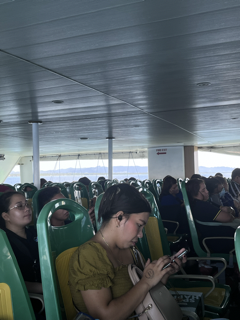
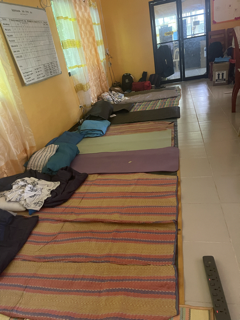
Putong
A putong is a traditional ceremony performed in Marinduque. During these ceremonies, visitors are honored and welcomed. I really wasnt sure what to expect the first time, but it was fun and special. Locals gathered and sang to us as they placed crowns on our heads, gave us flowers, and showered us with confetti paper, flowers, coins, and candy. During the ceremony everyone was so happy and laughing. We couldn’t let the crowns fall off our heads as we tried to grab the coins and candy being thrown at us, and we were instructed to keep the coins for good luck! At the end of the song, everyone took lots of pictures and there was so much food for us to eat. Kennady, Lukas, and I got to experience this ceremony twice, both times were incredibly special. This ceremony doesn’t occur regularly because it isn’t super common to have visitors. It was even more special to have white people at the ceremony which is why everyone wanted to take pictures with us. The second time we had more of a communal feast where we all ate together with our hands off of banana leaves! We were instructed to eat the food in front of us which included fresh pineapple, rice, chicken curry, fish, salted duck egg, tomato, and cucumber. It was a lot of food and when we finished our food we had to say Tapos (done)! I got cheered on to finish all my food and was even applauded for eating so well with my hands. We got to keep our crowns from the first ceremony! The fresh flowers we were given had santan flowers, which have a small drop of sweet nectar if you suck on the stem. We got to experience this ceremony three times, each was a little different, but all very fun and special.
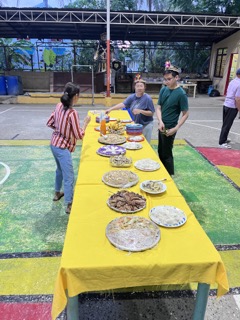
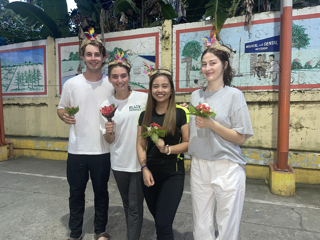
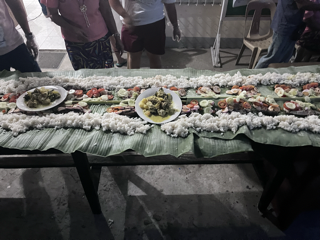
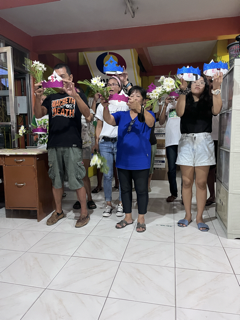

Data Collection Process Day 1
Field researchers start to collect data on the first day, their data collection is on going throughout their time in the barangay so it must start asap. Each field researcher is accompanied by a local official to ensure their safety, they must first locate the households before conducting any interviews. The first interview starts with a basic Covid-19 screening, an informed consent form, and an initial basic demographic interview.
Team leaders spend the first day going to the mayors office of the town doing a courtesy call. At this time they introduce themselves and explain the purpose of the data collection. The team leaders also buy snacks to give participants after the biomedical component of the data collection, blood collection.
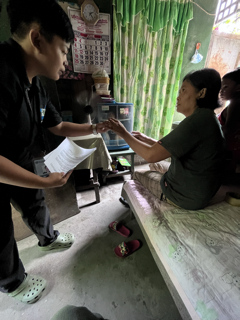
VS
Work I did on Day 1: 6.20
We spent the morning with the team 2 team leaders doing the courtesy call. Unfortunately, we didn’t meet with the mayor of Gasan, but we did introduce ourselves to his secretary and explained the data collection process and purpose.
After lunch I followed Ma’am Daph and a local official to conduct an initial demographic interview. Sometimes these initial interviews can be lengthy, it depends on the number of residents per household. Prior to the interview, the respondents temperature is taken and there is a short questionare about Covid-19 to make sure they are not sick
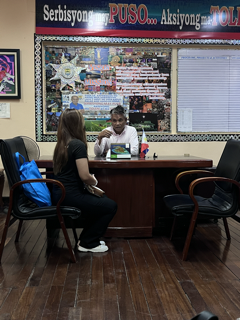
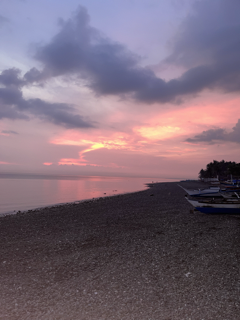
Data Collection Process Day 2
On the second day, everyone wakes up early to start working.
In the mornings, the two anthropometric researchers start taking measurements around 6am. Luckily the families come to them. They start with another Covid-19 screening and temp check prior to body measurements. Measurements include height, weight, mid-upper arm circumference, hip circumference, waist circumference, and blood pressure. Typically this part of their data collection is done before lunch, leaving the rest of the day for individual and household interviews. These interviews are very lengthy and take over an hour per household member.
The biomedical researcher and assistant collect blood and urine samples after the anthropometric data is collected. The respondents get snacks after the blood collection and are asked to sit down for a few minutes to make sure they don’t pass out. The blood and urine samples are sent back to Manila to be tested, the only on site testing is hemoglobin. Respondents blood and urine is test for vitamin A, zinc, crp + ferritin, fasting glucose, lipid profile, hbA1c, liver function, and pre-impaired glucose tolerance. There are also special tests done for certain demographics such as lead tests and folate tests.
The two dietary researchers work with the households to determine which time they will go to their houses. The dietary researchers have to go to the participating households multiple times for one day; first they go before breakfast to weight the raw, unprepared food prior to preparation; they go again before lunch to weigh plate waste from breakfast and weight the raw food prior to its preparation for lunch; they go again before dinner to measure plate waste from lunch and weight the raw, unprepared food before dinner; they go once more after dinner to measure plate waste from dinner. Depending on the household heads availability, at some point in the day the dietary field researcher must also conduct a food recall interview. This interview is about the food the respondent has eaten the day prior.
These are long days for all the researchers and is on going daily until every target household is accounted for.
Throughout the day, researchers are editing their data on paper and inputting it into the electronic data collection system.

VS
Work I did on Day 2: 6.21
I woke up early to help with anthropometric data collection. I practiced taking body measurements and did some observing too.
First the respondents height and weight is taken twice for accuracy. The two weight measurements must be between a 0.30 kg difference, the two height measurements must be between a 0.50 cm difference. If the difference is more than the specified value, the researcher must take a third measurement and record two measurements that satisfy the acceptable difference.
To take the MUAC (mid-upper arm circumference) you and the respondent must be standing, you take the respondents left arm and instruct them to hold their palm up at a 90 degree angle. You measure from the tip of the shoulder to the tip of the elbow (olecranon process to the acromium) and take half of that measurement to measure the circumference of the respondents arm. The researcher must also measure waist and hip circumference. To find the respondents waist, you must measure the length between the pit of the respondents rib and iliac crest and find the middle. To find the respondents hips you must find the iliac crest and measure 10.1 cm down. After these measurements are taken they are marked as completed. Each of these measurements is taken three times, if each reading isn’t within the acceptable difference range- the researcher must redo all three measurements. The acceptable difference between readings of MUAC/Waist/Hip circumference is 0.5 cm. Some measurements are also accompanied with notes to comment on a respondents physical remarks incase measurements may seem off.
Before and after lunch, I went with Ma’am Sam to observe and help with dietary research. We walked through farm land to reach two households. I was able to weigh the respondents unprepared food for before lunch and helped input the data.
I have so much respect for the field researchers, they wake up early in the morning to work long days. It is super hot outside and often times researchers sleep on the floor without air conditioning. They are able to accommodate very well depending on what each location is like. Living out of suitcases isn’t easy, especially when you are doing it for months at a time. Also not having any days off and working all the time is a little stressful. All of the researchers are always super friendly and helpful. Even though there is a language barrier I have had some great convos- when we don’t understand each other we just laugh.
We ended the day with bucket showers, watching the sun set, snacks from the sari-sari store, and meeting locals.

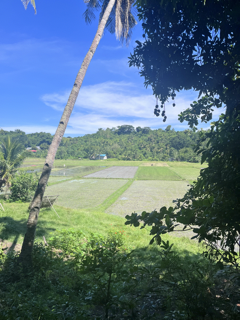

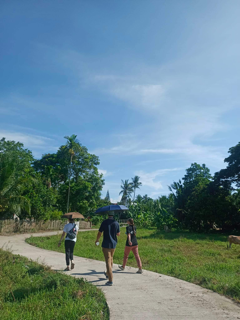
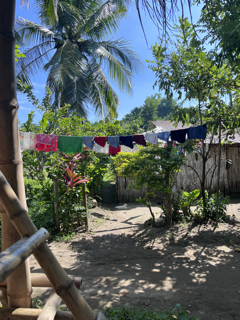


Data Collection Process Day 3
Everything from day 2 is repeated on day 3 until every target household has been accounted for.
Between data collection, field workers spend their time taking naps and/or editing data.
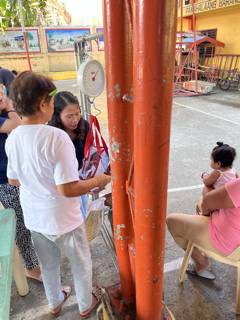
VS
Work I did on Day 3: 6.22
Again I woke up early to observe and help collect anthropometric data. We are staying right above a school so in the morning kids come early to play basketball and run around- except while we are there they cant really do that. The kids had seen us before, but this morning was the first time we got to say hi. We talked to them in English and they tried their best to respond, but most of them don’t know much English. We took some pictures together and during their recess they played basketball with us.
After lunch, most of the anthro and biomedical data had been collected for the day. We took a trike to go to the market. I finally bought clackers (lato-lato). We also bought food for dinner and snacks for our adventure tomorrow.
Again we ended the day with bucket showers and watching the sunset! Tonight the electricity went out for about an hour so we had to eat dinner in the dark.
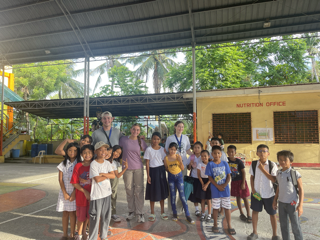
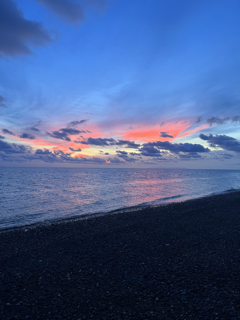
Data Collection Process Day 4
Everything from day 2 is also repeated on day 4 until every target household has been accounted for.
Depending on the number of households each subteam is assigned, the researchers may have more days of work. Around this time, most of the actual data has been collected and researchers are working on editing and inputting data prior to having their team leaders looking over it and submitting their work.
VS
Work I did on Day 4: 6.23
We woke up early again, but this time we got to have a relaxing morning on Gaspar Island. We took a boat ride to the island, ate breakfast together, and swam. The locals made us lunch which was fresh fish, rice, and an assortment of veggies. We ate off a banana leaf and ate with our hands!
We spent part of the afternoon observing as the researchers mostly edited their data, and we also took a nap. Later in the evening was our first Putong. We packed our bags and prepared to leave to another subteam tomorrow.
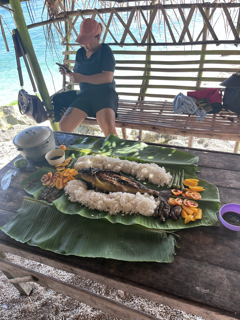
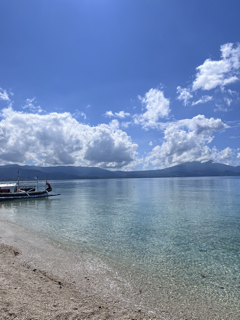

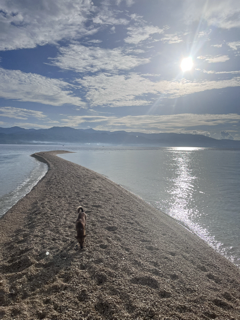
Data Collection Process Day 5
Depending on how many households each subteam is assigned, work may be close to done at this point. Toward the end of data collection in a barangay, researchers spend a lot of time editing their written data before inputting it into the database.
VS
Work I did on Day 5: 6.24
Today we switched from subteam 3 to subteam 1. Subteam 1 was in Barangay Caganhao in Boac. We spent the morning introducing ourselves to the new subteam and observing as they edited their data. We got to experience another Putong later that evening. The electricity went out after the ceremony was over and didn’t turn back on until the morning. It was a very sweaty night!
Data Collection Process Day 6
Subteam 1 completed their data collection in and prepared to transfer to another barangay in Boac. At the new barangay they must complete another courtesy call for the local officials to introduce and explain the data collection.
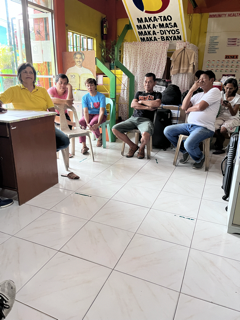
VS
Work I did on Day 6: 6.25
We observed the transfer process of a subteam. We introduced ourselves during the courtesy call and enjoyed a few snacks the local officials prepared for us. We all ate lunch together and got some souvenirs. We went to the national museum together. We then experienced our last Putong in Marinduque, and finally sang some karaoke! We leave tomorrow afternoon to go back to FNRI.
